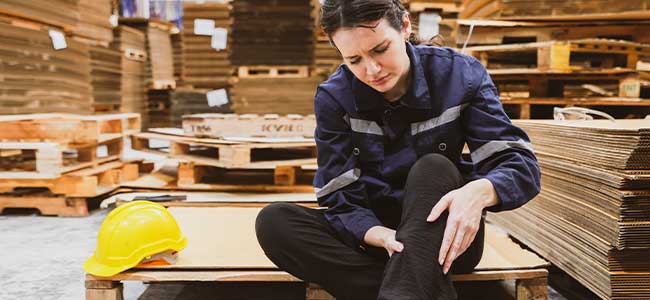
Foot Protection for Women
Proper footwear fit is critical to performance and safety for women on the job. What is the research around women’s foot design and which features go into ensuring women’s safety?
- By Dan Feeney
- Aug 01, 2024
Work boots serve several vital functions. The safety toe protects the upper of the foot. Robust soles shield the underfoot. Expertly designed traction reduces the incidence of tripping. However, when optimizing shoes for safety features alone, the resulting footwear products sacrifice efficiency and fit and amplifies many daily challenges for workers. The impact on women is outsized due to inaccurate size grading from the associated men’s last and cuff of the boot.
The Daily Impact of Improper Fit
Over the course of a workday, female workers spend hours of standing, walking, and lifting heavy objects. These actions require the musculoskeletal system to produce forces. Any mismatch in fit of the product to the worker can cause inefficiencies, slowing the worker down and predisposing her to injury. Footwear products should enhance the fit in addition to other safety features to decrease injury risk and enhance ankle stability and efficiency. Properly fitting, ankle stabilizing footwear is essential for women’s performance and safety on the jobsite, but as current designs often fail to account for gender-specific anatomical differences, there is an increased risks of injury and inefficiency.
Workers recognize the negative impact from prioritizing safety features over fit. More than half of surveyed workers reported pain or fatigue in their feet, knees, hips, and backs with many associating their ailments to poorly fitting footwear. Common safety modifications (e.g. safety toes, stiff cuffs) can limit normal gait function in workers, with female workers again baring an outsized impact.
For instance, the internal dimensions of work boots were compared against the dimensions of over 200 workers’ feet and showed most workers had excessive space in the length and inadequate width in the boots, which can result in a tripping hazard. Moreover, poorly fitting footwear, as seen in the study, can result in excessive “toe clawing” (or bunching of the toes) to stabilize the boots onto the foot. Consumers should find footwear that provides both the necessary protection and matches their foot dimensions to enable efficient movement throughout the day.
Anatomical Differences in Footwear Fit
Even in identical foot lengths, there are gender-specific anatomical differences that affect the fit – and therefore performance – of footwear. On average, women have a larger calf and ankle circumference than men with the same length foot. Women also tend to have a higher arch, smaller instep, and a shorter metatarsal length from the heel than men.
When brands create a single shoe size first and then scale the parameters up and down, called size grading in the industry, it is a challenge to make the product conform to a wide variety of potential users. The typical safety toe design increases the volume of the forefoot and reduces the arch height to compensate. As women tend to have higher arches than men (with the same length foot), this proves problematic. Recent evidence suggests footwear designed to wrap over the instep can improve fit, enhancing efficiency during rapid changes of direction and movement on uneven terrain. Female consumers should explore brands, widths, and models to find products that provide sufficient heel hold, width to allow toe splay, and a conforming fit that wraps around their arch and instep while approximately matching the length of their foot.
Reducing Injury Risk with Proper Fit
Lateral ankle sprains are the most prevalent injury in physically active populations, occurring when the foot inverts (sole of the foot turning inward) so quickly the muscular system cannot react to stop it. Some evidence demonstrating that women may have greater ankle laxity than men, putting them at higher risk for sprains.
A popular solution to reduce ankle sprains is using hard and stiff materials to prevent the lateral inversion of the foot. However, stiff material can also decrease movement efficiency as users struggle to overcome the rigidity of the brace. If boots have overly stiff soles and shafts, workers move with excessive plantar pressures on the metatarsal heads, putting them at increased risk for stress fractures and ankle sprains.
Moreover, there is a documented link between occupational footwear and musculoskeletal injuries, potentially from inadequate ankle stability or the overuse of compensatory muscles to make up for inadequate fit. Boots with a stiff upper cuff can inadvertently increase trip, slip, and fall risk due to challenging workers’ dynamic balance.
In contrast, Honert and colleagues found benefits in footwear designed to conform and wrap over the midfoot, with ankle stability improving by up to 5 percent and heel hold increasing by up to 2 percent. To provide the greatest benefit to workers, boots should balance an appropriately stiff cuff with flexibility for the lower limb, allowing workers to regain stability quickly and prevent ankle injury. Much like ski boots which have specific stiffness profiles based on the mass, flexibility, and sex of the user, female consumers should find a boot that augments their body geometry and flexibility.
A majority of workers report musculoskeletal pain because of their occupation. Female workers can reduce the likelihood of experiencing this pain by searching for optimally fitting and conforming footwear. Footwear brands also play an important role in improving safety and efficiency for female workers. They should take male and female average foot shapes into account when building lasts and improve foot-shoe coupling. Moreover, footwear designed to conform and wrap around the instep and lower limb, in contrast to highly stiff boots, can enhance ankle stability and efficiency. Workers and manufacturers must prioritize fit alongside safety features to enhance performance and reduce injury risks.
This article originally appeared in the July/August 2024 issue of Occupational Health & Safety.